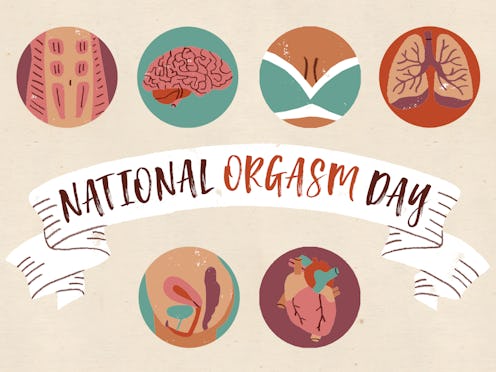
Whether you've had them a bunch, or are still figuring it all out (and hey, that's normal), orgasms are a big part of life. You might recognize them by their sensation alone, but it's interesting to find out how orgasms affect different parts of the body. Your body is really putting together a solid team effort when reaching that crucial point of sexual satisfaction.
As it turns out, July 31 is National Orgasm Day. And while it's not super clear how this holiday got started, it's definitely a good excuse to learn more about your body (and maybe get a little frisky at night). Since it's been reported that between 50 and 67 percent of women are prone to "faking it," now's the time to figure out what truly makes your body tick, and what kind of stimulation that you, personally, enjoy. It's different from person to person. There's not one surefire way to solve a lack-of-orgasm problem for all, but taking the time to figure it out will definitely be a worthwhile adventure that'll help you embrace your sexual side even more. J. D. Salinger has been attributed to the quote, "a woman’s body is like a violin and all, and it takes a terrific musician to play it right" through his writings, and hey, he was pretty much exactly right.
In order to understand your orgasms — both of the past and the future — a bit better, take a look and see which parts of the body work together when an orgasm takes place.
1. The Brain
In general, the brain stimulates blood flow to your genitals after receiving thousands of pleasure signals from nerve endings. These signals begin as you become aroused. There's a lot going on up in your brain during an orgasm, so let's break it down a little bit:
- Lateral Orbitofrontal Cortex: This is the behavioral part of your brain, which shuts down when you orgasm. This means that brain activity such as reason and control become impossible for a brief moment.
- Amygdala and Hippocampus: This part of the brain reduces emotions when an orgasm hits, and instead makes women feel like they're in the midst of a trance-like state.
- Periaqueductal Gray (known as PAG): This part of the brain typically controls fight or flight response, and is shown to be active during an orgasm.
- Anterior Cingulate Cortex: This region inhibits pain so that women can feel pleasure during an orgasm.
- Hypothalamus: The hypothalamus helps release oxytocin, which leads to uterine contractions that make an orgasm feel the way it feels.
- Neurons: Neurons fire out dopamine, a neurotransmitter that makes women crave more sexual pleasure.
2. Circulatory System
The heart rate increases during initial arousal, and continues as the vagina swells from increased blood flow and gains sensitivity.
3. Respiratory System
Breathing gets heavier in the excitement leading up to an orgasm.
4. Breasts
During the first stage of an orgasm, nipples get erect and can harden based on sexual stimulation and pleasure, which is another symptom of the oxytocin release. Not only do a woman’s breasts become more sensitive during sex, but they can swell, too — sometimes up to 25 percent.
5. Stomach and thighs
Abs and thighs tend to tense up at the very start of an orgasm, thanks to signals from the brain.
6. Uterus, Vagina, Anus, And Pelvic Floor
During arousal, these organs receive an additional amount of blood flow and become engorged. They then start to rhythmically contract, which results in muscle spasms.
Images: Harriet Seed for Bustle